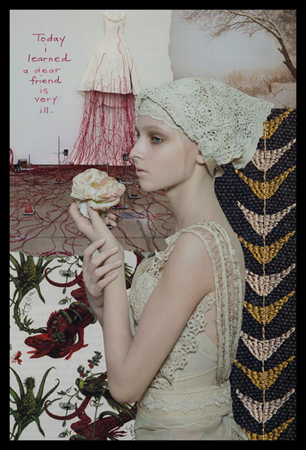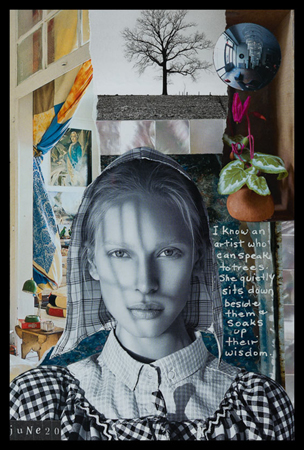
November/December 2013 issue, Selvege. A favourite fabric-related magazine of mine... see link at end of this article
Developing a Secret Code…
In Part I of this blog article, you learned of my fascination for fabric pattern prints and textures found in fashion magazines and my childhood home. While I noted, I used strips of these fragments for decorative purposes or to add colour or interest to a page, I also discovered they had the potential to convey personal meaning in my collages. They could allude to: life’s memories; be symbolic; evoke moods and emotions; add to the theme of a piece; give historical context or add insight into a character among other things. Realizing this excited me; it made me feel like I was developing secret code! Today I’ll share these ideas with you. Because I’ll be away next week, I’ve added some extra goodies in this segment for you!
Uncovering Your Personal Voice…
When choosing fabric (or other related) pattern prints and texture fragments for your collage/mixed media work, try to think about how they’ve been relevant to your life and the roles they’ve played. When composing an image, you have the opportunity to develop a personal visual language – instead of using a word to say something; you use an image to represent it. When you become good at it people will be able to “read” what you “write” with images. I’m always elated when people notice that I’ve used the same fabric pattern or texture element in several pieces. I know I’ve done my job when they can tell me what they’ve read into the recurrences of these fragments and what they might symbolize in my collage stories. More often than not they are right on; when they tell me something I’ve never thought of, I learn more about myself and those fragments.
If you haven’t had a chance to do last week’s homework (lol, I don’t blame you if you haven’t!), here’s a list of questions and reflections to help you discover your personal voice:
1) What kind of pattern prints or textures are you attracted to? Stripy, linear ones? Curvy, cosmic polka dotted ones? Textured ones: beaded, sequined, embossed or embroidered ones? Are there any others? Search for them in magazines, the real world or your memory in their various forms. See how many variations you can find say on a circular polka dotted style or a linear one and start seeing where you can use them to inform your pieces with visual meaning. Cut them out, draw, photograph or scan them and place them in a visual journal for your records so you can refer to them when composing.
2) Take time to investigate the history of classic patterns. Whether they’re stripes, plaids, polka dots, ginghams, leopard or camouflage prints they all have histories and functions and are associated with specific time periods and people. In fact, some of these patterns (ie. camouflage) are still evolving. I’ve always been drawn to paisley prints (my biological memory at work!); I love their intricate detail and floral patterning. While researching this print’s history, I found that it’s a blend of design from both Eastern and Western sources: India, the UK and Scotland – this is so cool considering my mixed cultural heritage. If ever I refer to this print in my collages, now you’ll know why!
Prints can allude to specific places… when I think polka dots I definitely think of America because my parents loved that US hit: “Itsy Bitsy Teeny Weeny Polka Dot Bikini”! Why do we think Africa when we see leopard prints or Scotland when we see plaids? Geographically-speaking the invention of fabric patterns can take us on an exciting journey around the world. In his quest to research certain fabric prints from Africa for his work, visual artist Yinka Shonibare, discovered they were produced in the UK. Where does your favourite pattern come from and what purpose(s) did it serve? What does it say about you as well as the culture(s) it comes from? Are there certain personalities associated with it that you have something in common with? Is it relevant to your life in some way? Can you use it in a piece to add that extra oomph to your work? These are intriguing questions to consider.
3) Once again, I ask you to take a walk down memory lane and recall the fabric pattern prints and textures of the fabric of your life. Do you remember details of your favourite outfit(s); your father’s much-loved tie or shirt; a movie star’s fabulous wardrobe; the décor in your homes; the architectural elements of memorable places you’ve visited, etc.? Be sure to include your landscape and urban excursions, too. Even the work of artists designing pattern prints are culled from their life experience. For instance, tapestry/wallpaper and fashion print designers William Morris and Sonia Delauney, respectively, drew their inspiration from observations of nature and the modern city.
My Walk Down Memory Lane…
I fondly recall the wooden mouldings of older homes I lived in as a child. I admired their beautifully carved elements above doorways, ceilings and staircases. I can summon up my parents’ tangerine-orange kitchen from the mid 1970’s: one side was covered with bold graphic floral wallpaper! The memory of a narrow navy blue and white tiled bathroom in our first home still haunts my dreams! It’s funny how the pattern prints and textures of things remain even if we don’t remember all the details of a particular time or place. They are precious souvenirs of a fuzzy past.
Examples of My Work…
In “Exile” I assembled elements that reminded me of my family home and the sense of alienation I sometimes felt there. I included patterned and textured elements: a handmade floral pot holder and tea towel (upper right) to suggest home cooked meals and the warmth of a family kitchen. The light blue wooden wall as well as the brightly painted façade of a house reminded me of the homes of outsider cultures like my Asian one – so different from the rest… filled with exotic objects and décor. I contrasted and added tension to this cozy scene with the addition of a fleshy-coloured leather n’ lace clad warrior girl reminiscent of Joan of Arc because I felt this rebellious religious figure’s spirit matched my own.
“Frozen” was born the day I learned a friend had cancer. While rummaging through magazines, I found a fragment of designer wall paper which depicted a disturbing scene of an iguana being strangled by a plant-like creature. In this collage, the blood-red iguana echoes the stringy vein-like tubes of blood emerging like tentacles from a gorgeous white evening gown. This dress once used for a joyous occasion now appears sickly and speaks so poignantly about mortality. I felt these two elements suited the anaemic looking child bride who grasps a delicate dying rose in her hand. In her beautiful embroidered floral dress she’s a bride of the winter of one’s life: destined for an untimely marriage with death.
In “The Tree Whisperer” I selected a figure clad in gingham and plaid. For me, these fabric prints symbolize the early days of farming and settlement in America. As a kid, I devoured Laura Ingalls Wilder’s: “Little House on the Prairie” book series. Since then I’ve always felt the kind of woman wearing this fashion was a wise, wholesome, hardworking one who possessed an intimate knowledge of the land – if anyone could talk to trees, she could.
The pattern prints and textures of the fabric of our lives have the power to add such a unique emotional and insightful depth to our art work. I hope you’ll find a way to bring your pieces to life through them.
When you speak through the images of fabric pattern prints and textures in your art, they may emerge not only on fabric but also drapery, carpets, wallpaper, wood panelling designs, etc.. Here are some great places to spot them:
– Fabric Stores or Warehouses (of course!)
– Paint/Wallpaper Stores
– Specialty Paper Shops (Ottawa: Paper Papier/The Papery; Paper Source online)
– Furniture Stores
– Fabric Remnant Bazaars (we have them here!)
– Vintage Clothing Shows
– Antique Fairs
– Garage Sales
*Note: I’ll be taking a break next weekend. I’ll connect up with you again on February 2, 2014. Have a great week!
Other Related Links:
Selvege Magazine
Part I: The Fabric & Patterns of Everyday Life
Going Gaga for Magazine Textures




Leave a Reply